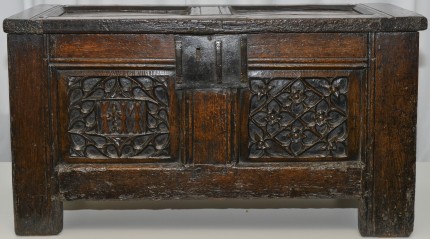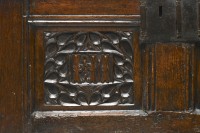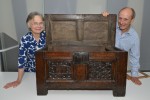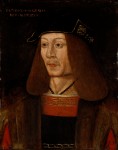
University of Aberdeen experts have confirmed that an oak chest acquired by a collector was made for the 1503 wedding of King James IV of Scotland and Margaret Tudor, daughter of King Henry VII of England. When antique furniture collector Aidan Harrison researched the carvings on the chest he’d acquired a few years ago, he found they were very similar to the iconography associated with the history-making union celebrated in person (there had been a proxy wedding in England a few months earlier) at Holyrood Abbey in Edinburgh on August 8th, 1503. One of the carved panels on the front of the chest features the IM monogram (for James and Margaret) linked by a love knot, a symbol of their marriage that was repeated in multiple decorative elements.
 Harrison brought his research to art history Professor Jane Geddes from the University of Aberdeen. The university has a facsimile of the Hours of James IV, an illuminated prayer book made as a wedding gift for Margaret (the original is now in the Austrian National Library in Vienna), so Professor Geddes was able to compare the design on the chest to the Book of Hours.
Harrison brought his research to art history Professor Jane Geddes from the University of Aberdeen. The university has a facsimile of the Hours of James IV, an illuminated prayer book made as a wedding gift for Margaret (the original is now in the Austrian National Library in Vienna), so Professor Geddes was able to compare the design on the chest to the Book of Hours.
“The similarities between the carvings on the chest and the illuminations in the Book of Hours are striking. Three illuminated documents relating to the royal wedding all show the IM monogram (James and Margaret) tied together with a similar love knot, just as it is carved on the chest. This was such a trademark for the union that even the floor tiles for Linlithgow Palace were made with the same design. James gave the palace to his bride for a wedding present. The tassels on the knot are shaped as thistles, a reminder of the king and his country.
“A wooden chest was one of the most important items of medieval furniture, because aristocratic families spent so much time travelling with pack-horses all around the country to their various homes. All the royal bride’s personal items would be kept in a chest like this. It is remarkable that it has survived for so long before its significance was fully appreciated.”
 The chest and the facsimile Book of Hours will go on display together at the University of Aberdeen’s Sir Duncan Rice Library. This is especially meaningful for the school because William Elphinstone, Bishop of Aberdeen, accomplished diplomat and founder of the university, played an important role in negotiating the wedding.
The chest and the facsimile Book of Hours will go on display together at the University of Aberdeen’s Sir Duncan Rice Library. This is especially meaningful for the school because William Elphinstone, Bishop of Aberdeen, accomplished diplomat and founder of the university, played an important role in negotiating the wedding.
The hope was that the marriage of James and Margaret would end hostilities between the countries and establish a lasting peace. Their marriage treaty was signed the same day as the Treaty of Perpetual Peace (January 24th, 1502), an agreement that would prevent the countries being dragged into war over border skirmishes. Although the Treaty of Ayton had established a truce between England and Scotland in 1497, it was slated to expire in 1504. The Treaty of Perpetual Peace was the first long-term peace treaty between the countries since the Treaty of Berwick had ended the Second War of Scottish Independence in 1357.
 Unfortunately it was perpetual in name only. Henry VII died in 1509 and his son Henry VIII was keen to make a name for himself on the battlefield. In 1513, Henry VIII invaded France, expecting the treaty to keep Scotland out of it. Scotland had been allied with France for centuries, however, and by the terms of the Auld Alliance of 1295, France and Scotland were to come to each other’s defense. James, hoping also to reclaim some border territory occupied by England, declared war on England and led his army into Northumberland. On September 9th, 1513, James IV met the Earl of Surrey at Flodden Field. It was a rout. James was killed along with 28 of his nobles, 50 knights and more than 10,000 infantry.
Unfortunately it was perpetual in name only. Henry VII died in 1509 and his son Henry VIII was keen to make a name for himself on the battlefield. In 1513, Henry VIII invaded France, expecting the treaty to keep Scotland out of it. Scotland had been allied with France for centuries, however, and by the terms of the Auld Alliance of 1295, France and Scotland were to come to each other’s defense. James, hoping also to reclaim some border territory occupied by England, declared war on England and led his army into Northumberland. On September 9th, 1513, James IV met the Earl of Surrey at Flodden Field. It was a rout. James was killed along with 28 of his nobles, 50 knights and more than 10,000 infantry.
 Margaret, who had opposed her husband going to war with her brother, was left regent of Scotland for her son, the future James V who was just over a year old when his father died. The crown of Scotland passed from James V to his daughter Mary, Queen of Scots, to her son James VI. After the death of Henry VIII’s daughter, Margaret’s niece, Queen Elizabeth I of England, James VI inherited the throne of England through his descent from Margaret. In 1603, a few months short of a century after James IV and Margaret spoke their vows at Holyrood Abbey, their great-grandson became James I of England and the two crowns were united.
Margaret, who had opposed her husband going to war with her brother, was left regent of Scotland for her son, the future James V who was just over a year old when his father died. The crown of Scotland passed from James V to his daughter Mary, Queen of Scots, to her son James VI. After the death of Henry VIII’s daughter, Margaret’s niece, Queen Elizabeth I of England, James VI inherited the throne of England through his descent from Margaret. In 1603, a few months short of a century after James IV and Margaret spoke their vows at Holyrood Abbey, their great-grandson became James I of England and the two crowns were united.